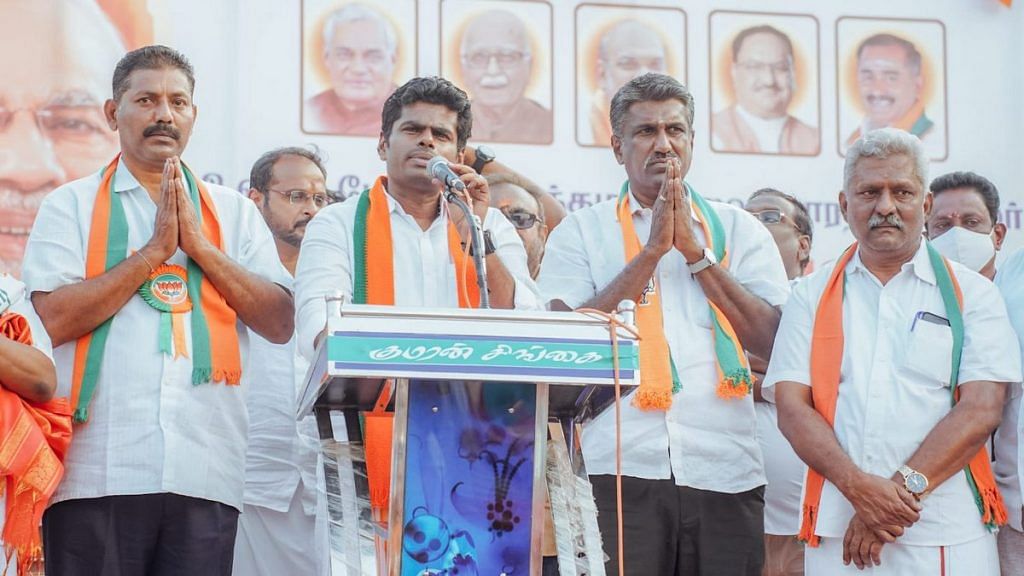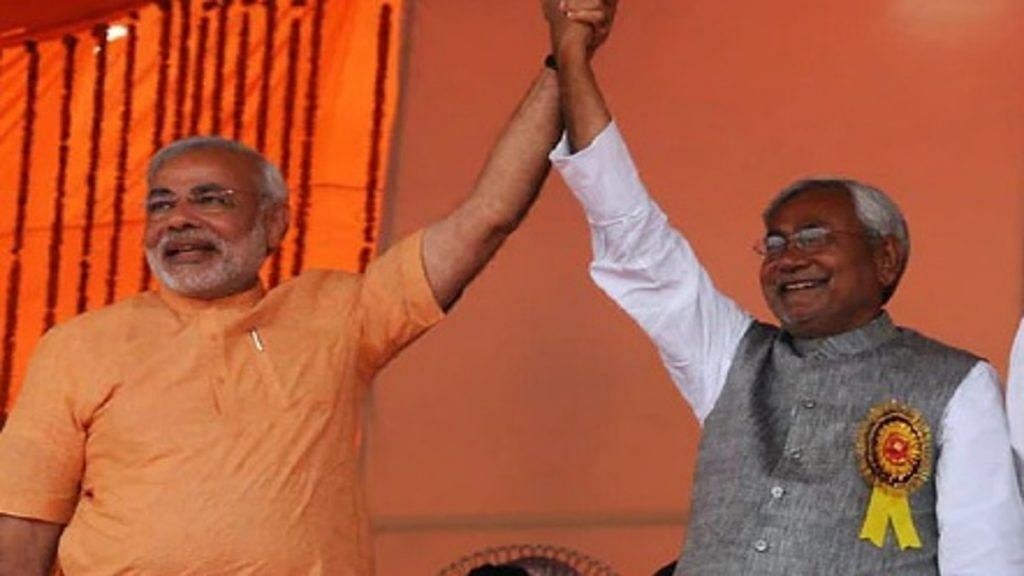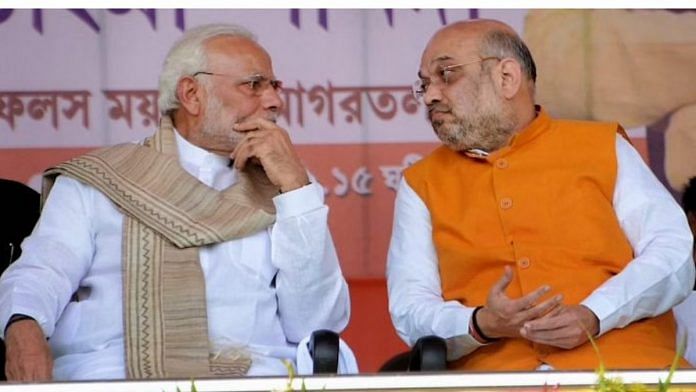New Delhi: The bitter war within the All India Anna Dravida Munnetra Kazhagam (AIADMK) has presented the Bharatiya Janata Party (BJP) with an opportunity to play a more active role as opposition against the ruling Dravida Munnetra Kazhagam (DMK) in Tamil Nadu.
Edappadi K. Palaniswami (EPS) and the general council members of the AIADMK expelled O. Panneerselvam (OPS) from the party’s primary membership Monday. Now, in its weakened state, the party may be more insecure than ever of the BJP and its aggressive expansionist attitude despite them being allies. This could potentially spoil the already-strained relations between the AIADMK and the BJP ahead of the 2024 general election.
But Tamil Nadu is not the only state where the BJP has been pushing hard to expand its presence. In Maharashtra, the BJP was accused of engineering a split in the Shiv Sena by backing Eknath Shinde’s rebellion against the then Sena chief minister Uddhav Thackeray.
In Bihar, The Nitish Kumar led JD(U)’s uneasy alliance with the BJP is no secret. The alliance that bloomed in the late 1990s has since become one of distrust and suspicion.
The BJP’s actions have altered the regional political landscape in many states and left other parties — allies or otherwise — watching its every move suspiciously. The most common complaint against the BJP is that the party does not honour coalition dharma.
Speaking to ThePrint, Bihar BJP leader and spokesperson Guru Prakash Paswan, said: “Many times, small parties demand things and their pressure is unjustified. Their calculations about their own poll prospects are also not realistic, so alliances break. Our party has to grow in areas where we are weak, so it may hamper prospects of other alliance partners sometimes, but that we are not faithful partners is untrue.”
The BJP leader gave the example of the Om Prakash Rajbhar-led Suheldev Bharatiya Samaj Party in Uttar Pradesh that had demanded eight Lok Sabha seats in 2019 for its continued support to the BJP. “Amit Shah did not budge and dumped Rajbhar. It did not break the alliance with Apna Dal, which bagged 12 seats in the assembly poll with BJP.”
According to Sanjay Kumar, professor and co-director of Lokniti, a research programme at the Centre for the Study of Developing Societies (CSDS), the BJP has honed a number of alliance strategies.
“The BJP has expanded horizontally and vertically by stitching caste alliances. It does not need long-term alliance partners, it only needs election-oriented partners to venture into new territories, so its dependence on allies is reduced,” Kumar said. “They have experimented in the past by inducting regional party leaders to combat opponent parties with a strong presence in their respective states.”
Also read: ‘Marriage of compulsion’: Why AIADMK is unlikely to break up with BJP despite public discord
In Tamil Nadu
In 2016, the BJP had contested the assembly election from all 232 seats in the state and won zero, while the AIADMK claimed 136. In 2021, the BJP contested the assembly polls again, this time with the AIADMK as part of its NDA alliance, and bagged four seats, while AIADMK won 65.
Although it still emerged as the principal opposition to the ruling DMK, AIADMK’s alliance with the BJP did it no favours, but helped the latter gain a foothold in the state assembly.
The BJP, though, last month, slammed the AIADMK and accorded itself the status of being the “best opposition” in Tamil Nadu. BJP vice-president V.P. Duraisamy said that the party’s four MLAs were “doing a better job in the state assembly than the 65 AIADMK lawmakers”.
“The AIADMK has failed to do its job as an opposition. It should have brought out the corruption of the DMK. But its leaders are remaining silent, fearing raids,” he said.
On 2 June, the AIADMK organisational secretary C. Ponnaiyan hit back at the BJP for “betraying” Tamil Nadu in the inter-state dispute on Cauvery water and the Mullaperiyar Dam. However, later, the AIADMK distanced itself from Ponnaiyan’s comment.
The BJP’s Hindutva pitch to ‘free the temples’ from state control also has the ruling DMK worried.
In fact, just last week, BJP state chief K. Annamalai drew parallels between the politics of Tamil Nadu and Maharashtra and claimed that “an Eknath Shinde will emerge” in the state.
A source in the AIADMK claimed that the BJP’s plan is to “take over” as the main opposition in the state.
He added that IPS officer-turned politician Annamalai’s aggressive approach, the promotion of Hindutva, plus the “DMK’s regional identity card” may compel the AIADMK to fight to save its space in Tamil Nadu. “This can spoil the EPS-led AIADMK’s relationship with the BJP, which has already lost 19 alliance partners since 2014,” the AIADMK source said.

“The BJP’s relationship with other alliance partners in the past has always been tenuous, with the party even breaking off partnerships at the right time to protect its own interests,” the source added.
The BJP sources ThePrint spoke to said that the party will tread cautiously for the time being in preparation for the 2024 Lok Sabha poll, as it has to strengthen itself on the back of the AIADMK, but it will not ignore an opportunity to position itself as the main challenger to the DMK.
In Maharashtra
Over the past month, the leadership in Maharashtra has seen major turmoil with the BJP allegedly engineering a rebellion within the Shiv Sena, part of the ruling Maha Vikas Aghadi (MVA) coalition government in the state.
Since 1989, the BJP and Sena have been natural allies. The Shiv Sena-BJP alliance had jointly contested the assembly polls in the state for the first time in 1990. The Sena contested 183 seats and won 52, while the BJP ran as junior alliance partner in 105 and won 42.
Over the years, though, the BJP has become the stronger of the two. The Sena contested 126 seats of the state’s 288 in 2019 and won 55, and the BJP contested 162 and won 106.
The two parties, however, went their separate ways after Uddhav Thackeray asked the BJP for rotational chief ministership and an equal sharing of power and was denied.
The BJP has now been accused of nurturing the ambition of Shiv Sena’s Eknath Shinde to take the rebellion route to dislodge Uddhav Thackeray as CM.
In January, Uddhav had attacked the BJP and said, “Remember the days when BJP candidates used to lose deposits in elections? That time they needed us and other regional parties, like the Akali dal, TMC and Sena… but now these neo-Hindutvadis are using Hindutva only for their own benefits.”
Speaking to ThePrint, Sena MP Arvind Sawant spoke of the times when the Sena and BJP worked in tandem. “Like when the BJP did not allow Shiv Sena leaders to defect to join their party during the [Atal Bihar] Vajpayee-[L.K.] Advani era, or when Balasaheb Thackeray did not induct Gopinath Munde and Keshubhai Patel when both were inclined to join the Sena — this was how alliances were run, with trust and maturity. The BJP under [Prime Minister Narendra] Modi and [Amit] Shah has forgotten this.”
Also read: Another Maharashtra in making? Soren-Shah meet sets off buzz
In Bihar
The JD(U) and BJP have been allies for most of almost two decades, with Nitish Kumar leading the state for a majority of that period.
The BJP, after the 2020 assembly election, emerged stronger of the two with 74 seats to the JD(U)’s 43. But it continued to give its support to Nitish as the leader of the NDA government.
Over the years, though, the alliance has soured.
A senior JD(U) leader told ThePrint that the party now had differences over “many issues”, including “certain rules” around alliances.
“Every party has the right to expand… but there are certain rules that need to be kept in mind in politics when honouring alliances. We miss those years when Advani and [Arun] Jaitley regularly interacted with Nitish. It was like a family affair, but now things are different,” he said.

Earlier this month, the BJP allegedly helped R.C.P. Singh, a member of its NDA ally JD(U) in the state, to grab a ministerial berth in July without his party’s consent. In March, it had also nudged CM Nitish to sack Mukesh Sahani, a cabinet minister and a founding member of the Vikassheel Insaan Party (VIP), that was brought into the NDA fold during the 2020 assembly election.
In 2021, the BJP inducted Pashupati Kumar Paras, leader of the breakaway faction of the Lok Janshakti Party (LJP), into the Narendra Modi cabinet, at the cost of LJP head Chirag Paswan, which helped the BJP cut Nitish to size.
Nitish Kumar has also not forgotten an affront dating to the 2020 assembly election, when the BJP backed Lok Janshakti Party (LJP) leader Chirag Paswan in fielding 137 candidates against the JD(U), acting as a vote-cutter. Because of the Chirag factor, the JD(U) ended up losing nearly 30 seats, while the BJP became the bigger partner in the 243-member assembly with 74 seats, while the JD(U) got just 43.
It was a far cry from the 2005 assembly election, when the JD(U) had fought in 139 constituencies and won 88 seats, while the BJP had fought 102 seats and won 55. Similarly, in the 2004 Lok Sabha elections, the JD(U) fought on 26 seats and the BJP on 14, but the arithmetic had shifted in 2019, when both parties fought 17 seats each.
Notably, in 2020, six JD(U) MLAs in Arunachal Pradesh shifted to the BJP in yet another setback to Nitish.
Also read: This is BJP’s new caste coalition for 2022 UP polls — the 7 parties & its members
In Assam, Manipur, Andhra Pradesh
In Assam, the BJP dumped its former alliance partner, the Bodoland People’s Front (BPF), led by Hagrama Mohilary, in the Bodoland Territorial Council (BTC) in 2020 and joined hands with the United People’s Party Liberal (UPPL) to gain majority in the BTC poll.
In Manipur, it came to power in 2017 in alliance with smaller parties like the National People’s Party (NPP). The support of NPP’s four MLAs was crucial to the BJP to form the Biren Singh-led government in the state.
But their relationship turned turbulent when the BJP stripped NPP deputy chief minister Joykumar Singh of his portfolio following a conflict with Biren Singh and the NPP withdrew its support from the government.
After Union Home Minister Amit Shah and Assam CM Himanta Biswa Sarma intervened, the four MLAs returned to the coalition.
In the 2022 election, though, the BJP dumped the NPP and won a majority on its own, bagging 32 seats in the assembly elections.
In Andhra Pradesh, the Telugu Desam Party (TDP) broke its alliance with the BJP ahead of the 2019 assembly polls, fearing that they might lose the minority vote. After facing a humiliating defeat in the polls, the TDP got another rude shock when the BJP poached four of its Rajya Sabha MPs.
Speaking to ThePrint, BJP spokesperson Guru Prakash Paswan, said the BJP’s actions had bee justified in all these instances.
“Our former prime minister Atal Bihari Vajpayee stitched alliances with over 24 parties and served them well. The NDA still has many alliance partners. Sometimes confusion happens or unjustified demands are made, but we are not unfaithful,” he said.
Odisha: The one that got away
Odisha’s Naveen Patnaik-led Biju Janata Dal (BJD) was in an alliance with the BJP from 1998 to 2009, when the regional party broke ties following ideological disagreements and a fracas about seat-sharing in the assembly elections. The two parties fought separately, with the BJD winning 109 seats in the 147-member assembly and the BJP only six.
Since then, Patnaik has maintained a vice-like grip on Odisha’s politics. In the 2019 state elections, the BJD won 112 while the BJP bagged only 23.
Back in the 2000 assembly elections, when the BJP and BJD fought together, the BJD had won 68 seats and the BJP 38. In 2004, the BJD’s numbers in the assembly were down to 61 and the BJP had 32 seats.
Ever since the break-up, the BJP’s footprint in Odisha has dwindled, which highlights how the party’s earlier success was largely on the back of its then partner.
(Edited by Zinnia Ray Chaudhuri)
Also read: Manipur alliance with BJP has been ‘very, very challenging’, says NPP chief Conrad Sangma



